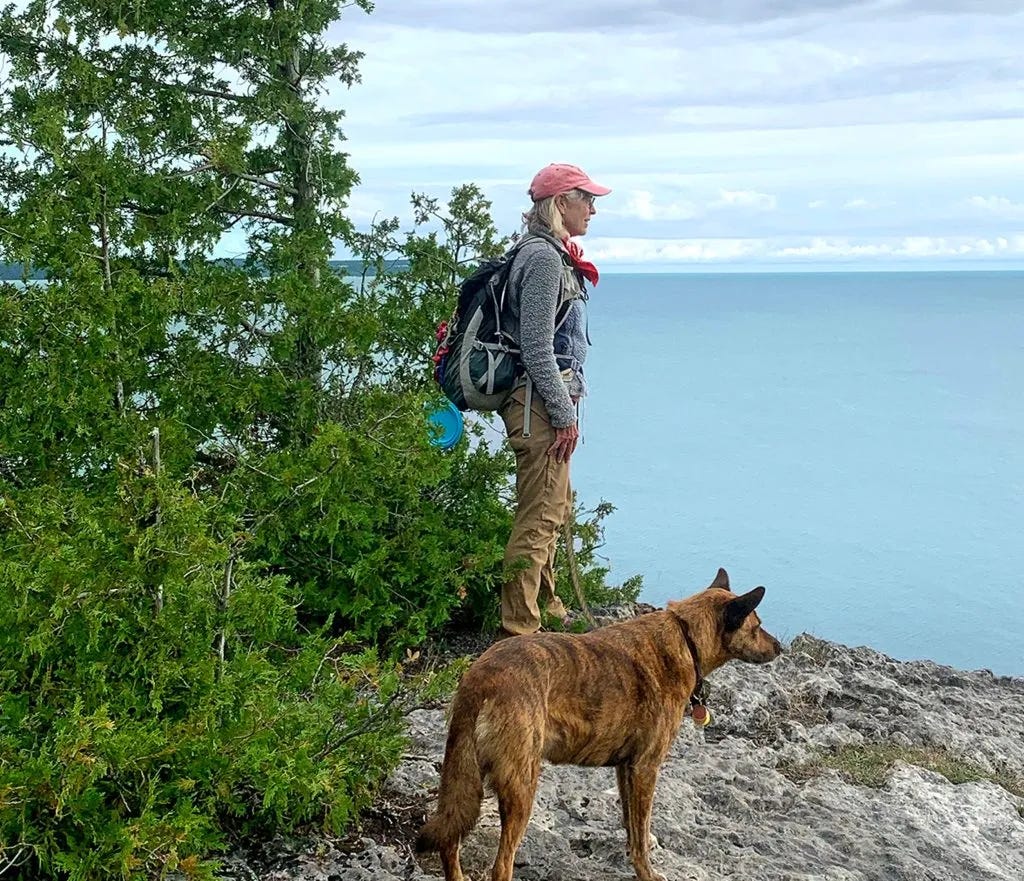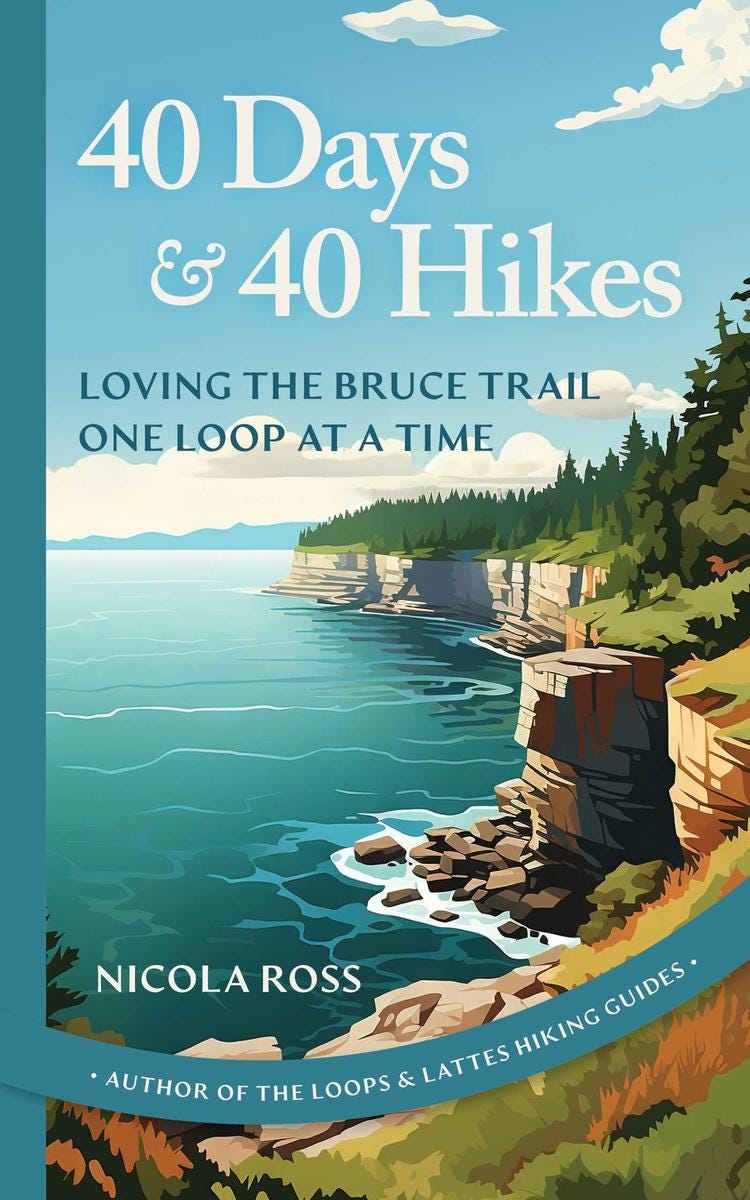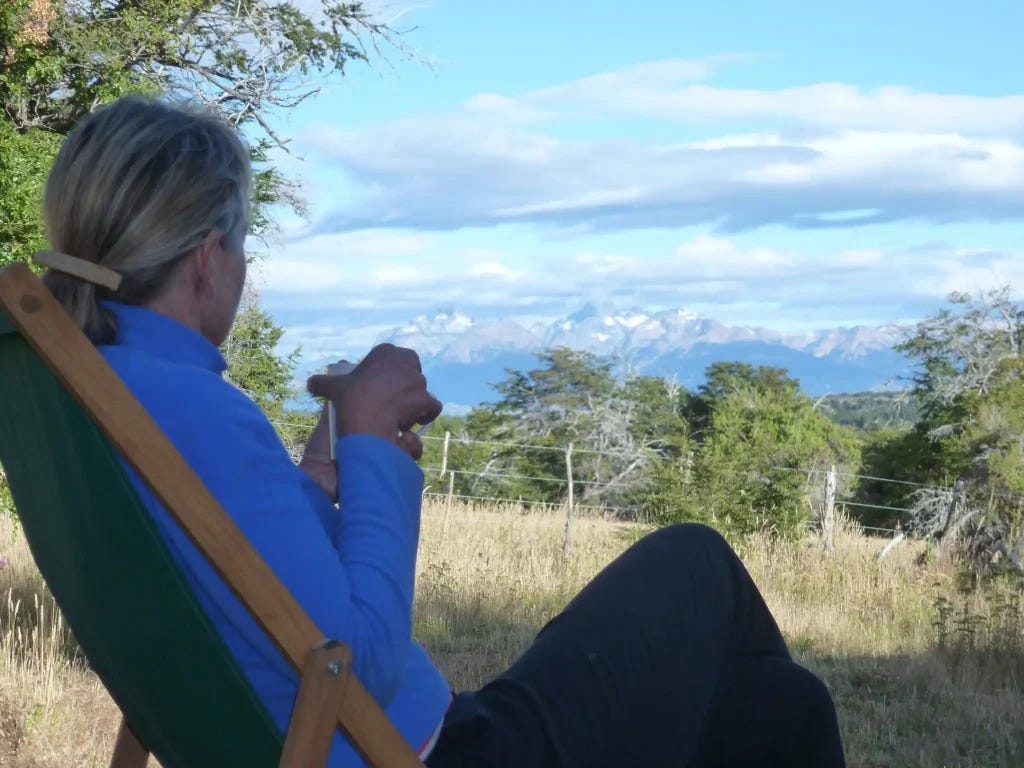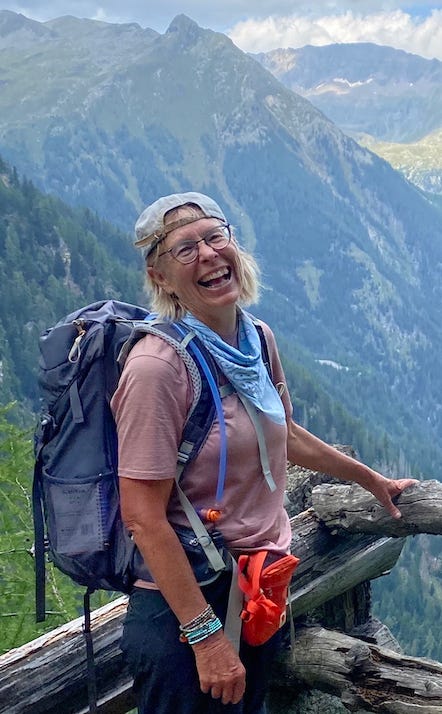Nicola Ross is the winner of numerous writing honours, including a National Magazine Award, and is the author of 12 books, including the bestselling Loops & Lattes series of hiking guides. Having sold over 50,000 copies of these self-published guidebooks, Nicola is a full-time writer and professional hiker. Formerly a climate change consultant, Nicola is a biologist and columnist with In the Hills magazine. Her articles have been published in The Walrus, The Globe and Mail, Explore magazine, Mountain Life, Avenue, Ontario Nature, Alternatives Journal, and more. She was a regular environmental contributor to CBC Radio in Calgary, regularly appears on the CBC Radio program Fresh Air and was the long-time editor-in-chief of Alternatives Journal, Canada’s national environmental magazine. She lives with her partner, Alex, in a converted sawmill (circa 1857) in Caledon, Ontario.
Her latest book, 40 Days & 40 Hikes: Loving the Bruce Trail One Loop at a Time, was published April 9, 2024 by ECW Press. Part illustrated memoir, part hiking guide and part good storytelling, it describes her journey along Ontario’s 900-kilometre Bruce Trail from Queenston Heights on the Niagara Peninsula to Tobermory on the Bruce.
I have a restless spirit, but am hefted to my home. I seem unable to leave it, much as hefted sheep don’t stray even when they are left to graze in a landscape without borders.
The Niagara Escarpment’s hills and valleys, its cliffs, streams, bank barns, brick and stone farmhouses, meadows, rocky soil and limestone course my blood. Someday maybe I’ll leave the place where I was born and raised, but not yet. There’s still work to do. Things to discover. Places to explore.
I never intended to become a writer, but a dozen books and hundreds of magazine articles later, I can no longer deny it. I’m not an imposter. I am a writer. And there is power in my pen. Power that I’ve been slow to recognize. Power to help protect the landscape that embraces me. Power to give back, to raise awareness, to encourage, to recognize and to celebrate.
- Nicola Ross, nicolaross.ca
Describe your writing space. What do you love about it?
I do a lot of writing at my Mac in my spacious second floor office overlooking Shaw’s Creek. In fact, Shaw’s Creek is so close to the old sawmill (circa 1857) that we live in that I have to get right up close to the window and look straight down.
My favourite place to write, however, is out in the field.
There’s something freeing about writing longhand because editing is difficult. I’d not thought about it before but it reminds me of the difference between drawing with a pen or a pencil. I’ve been taking sketching lessons and contrary to what I had expected, I found writing with a pen, which requires me to find solutions when I make errors frees up my sketching. Writing longhand does a similar thing, I think.
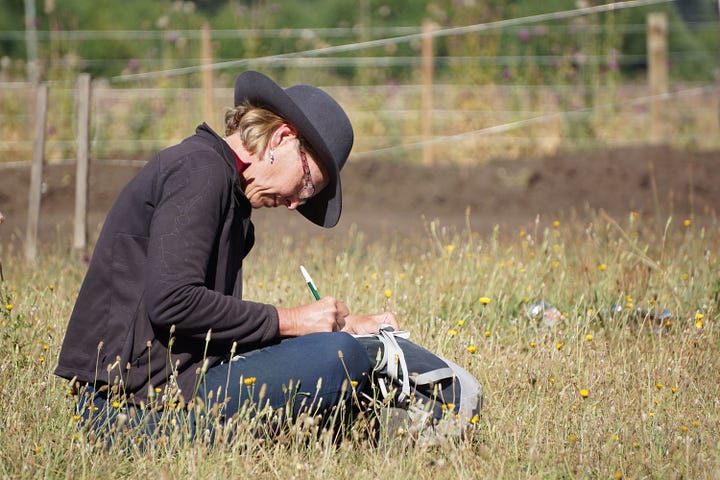
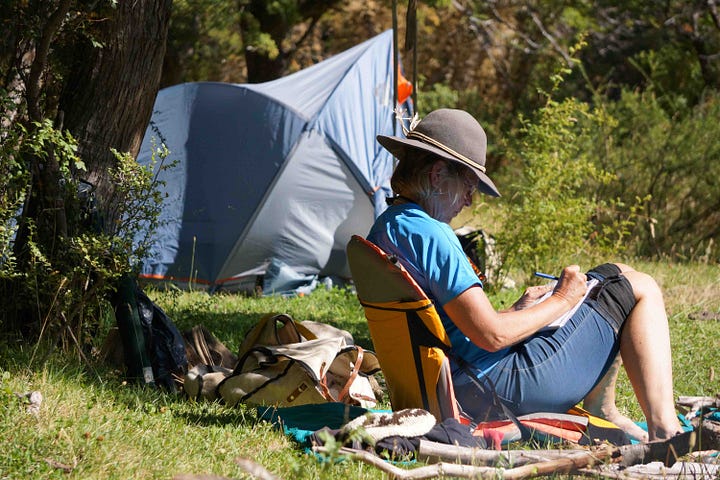
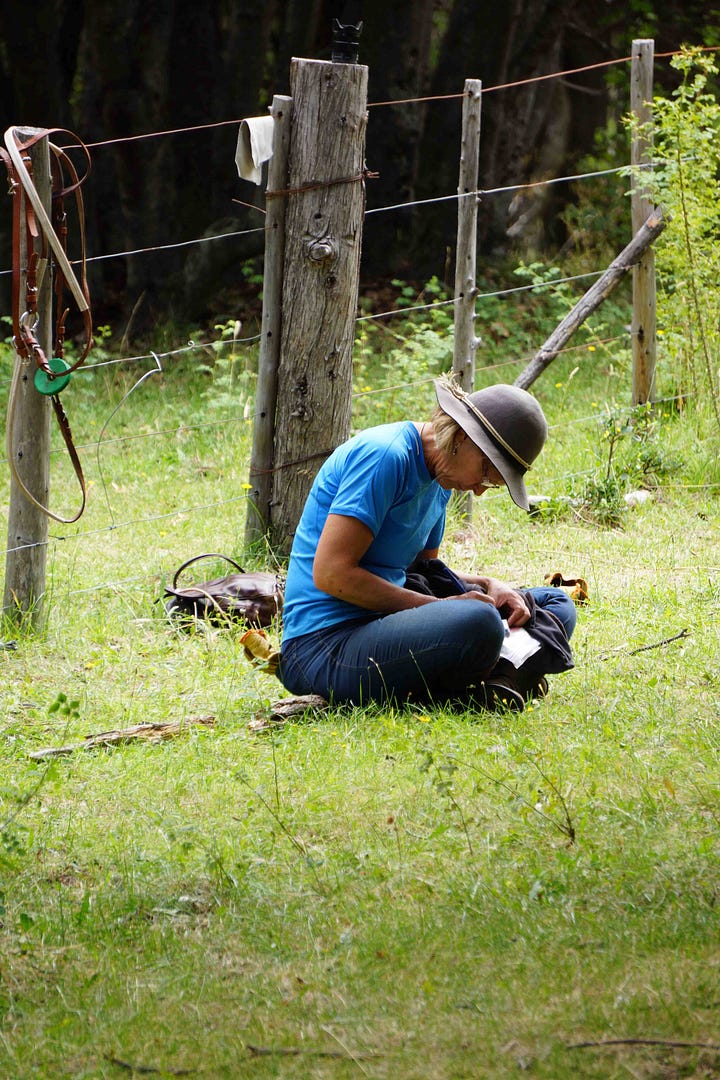
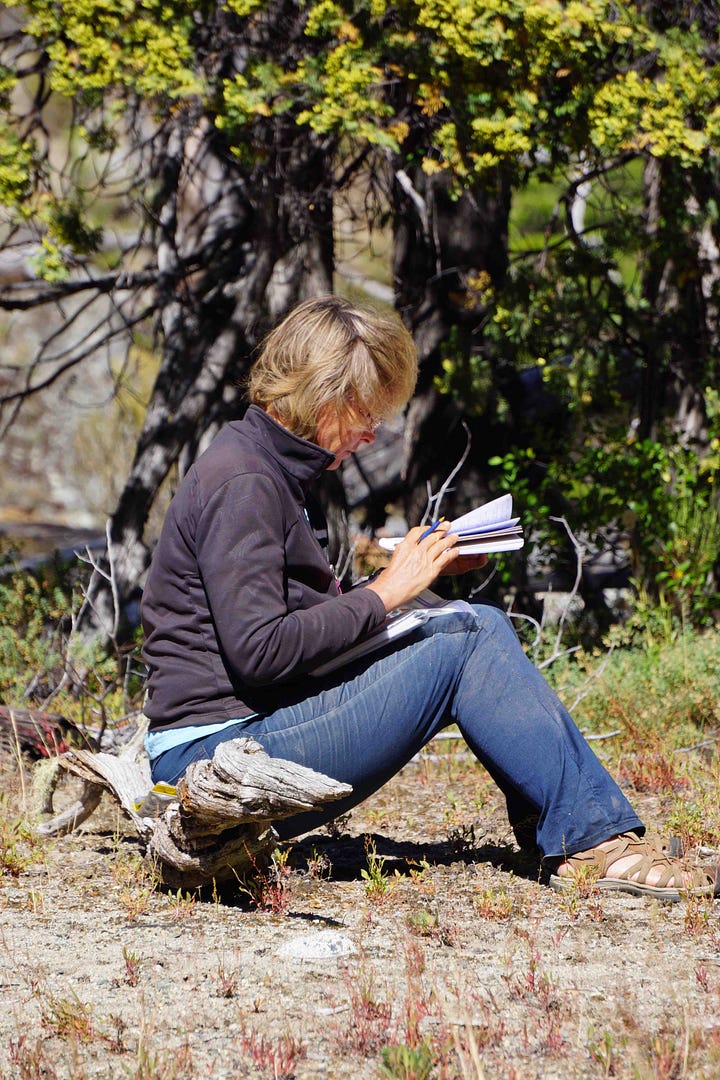
How important is it to have ‘a room of one’s own’?
When we bought our old mill, we call it the Little Mill as it’s the smallest of three mills in Alton, I had told my partner Alex that I had to have a room where I could close the door and leave my room as it was. I had been working primarily on our dining room table. I called it an office then. I think of it more and more as a studio, a term I prefer.
Any rules for when you’re in this ‘space’?
I don’t have to clean it up if I don’t want to.
It’s mine and I can do with it what I want.
It has to have good light.
It has to have a bed for my dog.
What is your writing practice like?
I write almost exclusively in the morning. Most of what I write after 1pm has to be rewritten in its entirety the next day. Rather than have a rule about writing every day or writing for some period of time each day or producing so many words on a daily basis, I write mostly when I have an assignment or project. When I’m working on a magazine article or a book, it’s hard to pull me away from my keyboard.
“My favourite part of writing is when I’ve done the research, or most of it, and get to sit down and start pulling it altogether. It’s an organic process for me. I’m not sure what will come next or how a specific fact or quote will fit until I get there.”
Do you quantify your process by word count or hours spent writing?
No, but I am really, really good with deadlines.
What is your creative process like?
I drive my partner and friends crazy because I’m constantly coming up with ideas for new projects. Some are writing projects, some are projects meant to promote/present/sell my writing. It’s a bit non-stop. What I find is that some of these ideas melt away; the next day I’ve forgotten about it. But every now and then an idea sticks and I’m off to the races.
What is the easiest and most difficult part of the process for you?
My favourite thing is editing. Once I’ve got the story down and it’s in pretty good shape, I love getting deep into the nitty gritty of wordsmithing.
I’m not so keen to get starting with the research although once I get into it and one lead leads to another and I find those rabbit holes, I have fun.
Why do you write?
Recently, I read a piece by Barry Lopez in Orion magazine. It was the Foreword to an issue of this journal entitled “Earthly Love.” Lopez wrote, “The experience (a journey through Alaska's Brooks Range) delivered me into the central project of my adult life as a writer, which is to know and love what we have been given, and to urge others to do the same." I realized that is exactly what I’ve been doing and continue to do with my writing and illustrating. I’m urging people to “know and love” these places. That is the “central focus” of my life.
How do you manage writing with other demands on your time?
I always ask for a deadline and since I’m good with deadlines, meeting them puts writing at the top of my list. House work be damned!
What has influenced you most as a writer?
Reading, definitely reading.
Do you want each book to stand on its own, or are you trying to build a body of work with connections between each book?
Most of my work, especially in the last decade, has evolved around my love of nature, the out of doors and getting into it.
Best advice you’ve ever been given.
Learn a second language – oh, you mean about writi
ng. The best advice? That’s hard as I’ve received so much advice. More recently, I am realizing how right Alain de Botton was in his book The Art of Travel. He writes, “Ten minutes of concentration at least are needed to draw a tree; the prettiest tree rarely stops passersby for longer than a minute.”
What does success look like to you?
Being healthy.
Tell us a few things that would surprise us to learn about you: the person, the writer.
I don’t walk very quickly.
I hate hiking – just kidding.
I’m not really a writer; my brother and sister and niece are the real writers. I think it’s called the imposter syndrome.
I lived in Calgary for 16 years and nearly went to work for the pesticide division of DuPont.
What can books teach us? How do they change us?
On the CBC the other day, they asked a writer to name three books that changed their life. Since hearing that interview, I’ve been asking my friends the same question. It took me awhile to come up with all three, but #1 was easy. It was a biography of Beryl Smeeton called High Endeavours. She was an adventurer extraordinaire. I learned from that book that I could do these things too. So my answer to your question is that books can teach us what’s possible and by doing so they can change us.
Which authors, living or dead, would you most like to discuss writing with?
Barry Lopez
Who are your favourite writers writing today?
John Macfarlane
Ann Pachett
Eden Robinson
What books are you currently loving?
These days, I almost exclusively read book about adventure travel. I’m reading a few of the classics, which is perhaps more fun than loving. Recently, I read Don Quixote and Patrick Leigh Fermor’s A Time of Gifts. At the moment I’m reading Robert Louis Stevenson’s Travels with a Donkey. Not long ago I read Paul Bunyan’s Pilgrim’s Progress (originally published in 1678).
If you were a bookseller what one book would you hand-sell to readers and why?
That’s not fair. Virtually no one else reads the adventure books that I read. But if I had to hand out one adventure travel book it might be something by Dervla Murphy or, if I had to, Bill Bryson.
What advice do you have for writers?
I think many people think that what they write says what they mean. But often it doesn’t. Readers are good at interpreting what a writer writes so they often understand what the writer means. But that’s not good enough. A writer needs to study each sentence to make sure it says what they mean.
Take a course in grammar and punctuation. I took one based on Strunk and White’s The Elements of Style and it was illuminating. Failing finding a course, read The Elements of Style.
Take writing courses.
When you have finished the article or story you are writing, really finished it, go back and reduce the word count by at least 20%. I’m serious.
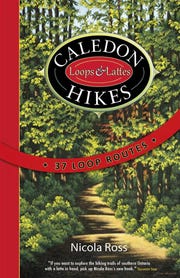
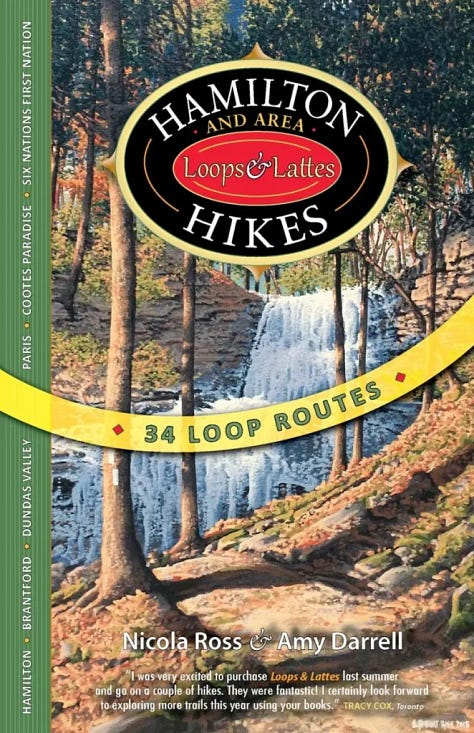
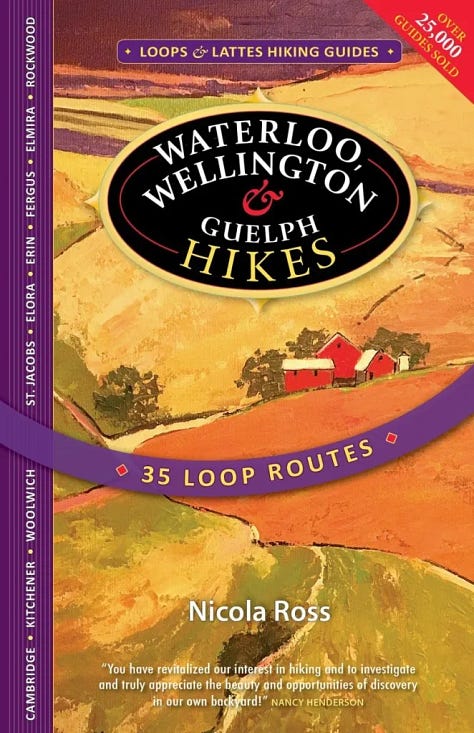
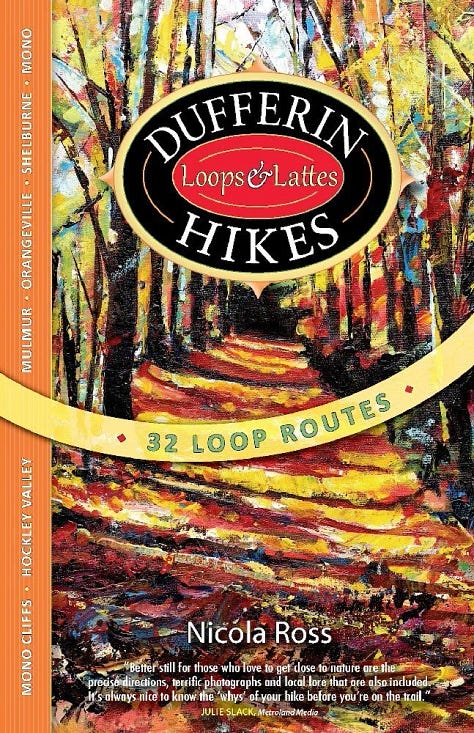
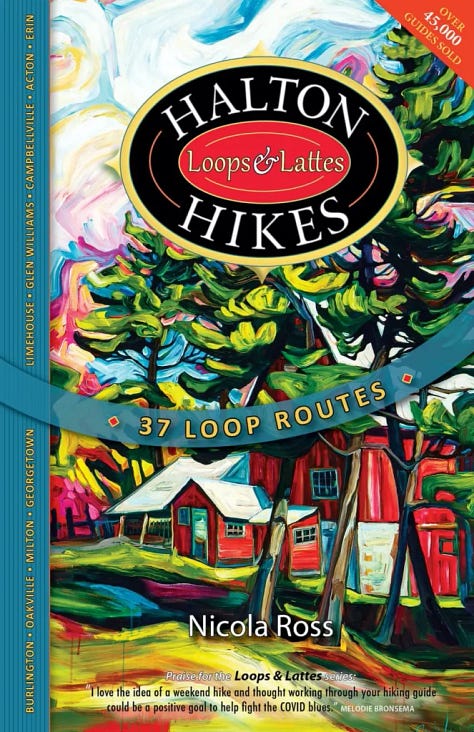
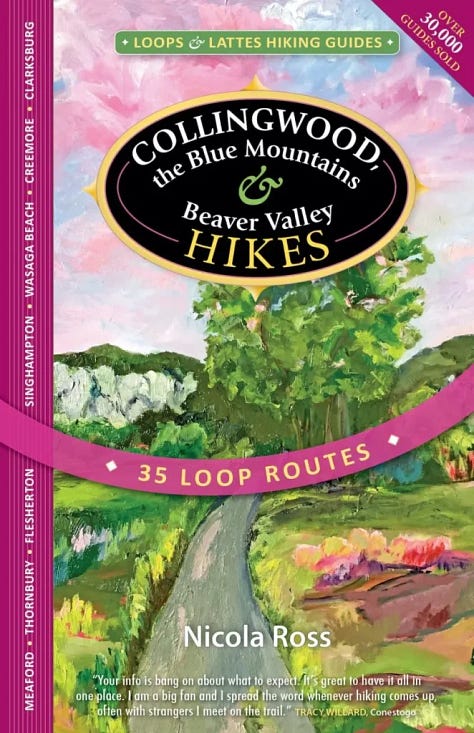
What’s next for Nicola?
In 2025, Nicola has set her sights on walking the 415-kilometre Andalusian Coast to Coast Trail and the 1000-kilometre Via de la Plata, both in Spain.
Among an emerging group of female adventure travel writers, Nicola is bringing the 2025 Women’s Adventure Film Tour to Southern Ontario. The event, to be held in her home village, involves a showing of half a dozen films as well as a series of panel discussions and interviews with female adventurers.
Thank you Nicola!
To learn more about Nicola Ross, and her writing, visit her at nicolaross.ca and loopsandlattes.ca


